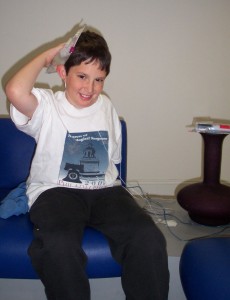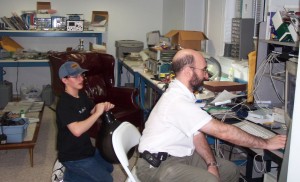The year was 2002, and 10-year-old Spencer Neff was a spunky boy with hydrocephalus, a buildup of cerebrospinal fluid inside his brain. A surgically implanted shunt – a tube to drain the fluid – was in place. Like all children with shunts, he was at risk for having the shunt plug up and malfunction, and he sometimes got scary headaches. But Spencer was lucky to have a neurosurgeon uncle, Samuel Neff, who offered him an interesting proposition: would you rather be paid to help with some research, or be a scientific collaborator? Spencer chose the latter.
Sam had been thinking: If Spencer gets a headache, is there a way to know for sure that his shunt is plugged—without having to go to an emergency room, have x-rays and scans, and perhaps a needle puncture into the shunt? Shunt malfunction can be life-threatening—and the uncertainly can be extremely frustrating. Was there a non-invasive way to check flow in the shunt?
Sam’s clever idea was to detect flow by chilling some of the fluid in the shunt with an ice cube, and then test downstream for a drop in temperature. Such temperature-related tricks are used elsewhere in medicine (to measure cardiac output, for example). With his sons Daniel and Rob (then an engineering undergraduate at Drexel University), Sam made prototypes in his home shop, circuit boards, algorithms to interpret temperature changes in the skin over the shunt—and convinced himself with benchtop data and some testing on Spencer that the idea worked.
This is not the first story about inventors inspired by a child in the family with hydrocephalus. The first commercially successful shunt valve was invented by John Holter, a machinist whose child was born with hydrocephalus and spina bifida. The famous children’s author Roald Dahl (“Willie Wonka and the Chocolate Factory”) invented the Dahl shunt valve, marketed in England.
But there were twists to come. A new device, even one that is safe and works, needs to be novel enough to be patented, so that a company can profitably produce it. And it needs to be cleared by the FDA—and here being too novel, too different from what exists already—can slow things down. Sam became deeply frustrated on both counts. He was concerned that there might not be anything patentable in his gadget, and that the FDA might not be willing to approve the device.
In fact, at a national neurosurgical meeting I attended, he presented the concept and why it should work—then offered to give the devices to any neurosurgeon who might like to use them. He thought a company would never make them.
I knew Sam casually, and talked to him privately after his presentation. I was pretty sure there would be a way to patent some aspect of the device (which is all that would be needed), and some way to get FDA approval. I thought this could be done as a “510(k)”—a relatively fast mechanism for approving medical devices that have substantial similarity to existing devices. I prevailed upon him to try again—the gadget was too promising to throw away.

ShuntCheck test: A: Three sensors are placed over the skin and an ice cube is applied for 60 seconds. B: The area of cooled skin is shown in blue. C: The middle sensor picks up a temperature drop in the fluid downstream of the shunt.
In the end, Sam formed a company with his brother Alan (Spencer’s father) and got a patent. Together they got 510(k) approval for the device now called ShuntCheck, and got funding to move it forward.
But here is where the story becomes very sad.
Sam did not get to see how things worked out. Quietly watching television at home one night, he suffered a myocardial infarction and died suddenly, at age 46. That same day, he had met with a very large shunt company, and it appeared that his device would be developed for widespread distribution after all.
Meanwhile, a study of 100 patients in this month’s issue of Neurosurgery, on which I was the first author, shows that ShuntCheck reliably picks up on the presence or absence of fluid flow in the shunt. But here’s a surprise: the study also found that patients can have flow in the shunt despite a genuine need to have surgery to fix the shunt—and, conversely, a patient who is not having problems, and does not need surgery, may have no detectable flow in the shunt.
This unexpected finding makes thinking about the problems of children with shunts more complicated than we might have hoped. Like many new kinds of data about patients, we need the numbers, but we also need clinical experience to know how to interpret the numbers in each patient. Measuring shunt flow in hydrocephalus does not instantly tell us who needs surgery—but it surely is important information that will take some time to sort out.
So the research on ShuntCheck is not complete. But Spencer, now a senior in high school, is doing well. Rob, the undergrad who worked for the family company, still works in medical device engineering, and Daniel is now a medical student at Jefferson Medical College. Sam’s passion for helping his nephew lives on—and the ice and ShuntCheck are telling us things about shunts we never would have known.
 Joseph Madsen, MD, is director of the Epilepsy Surgery Program in the Department of Neurosurgery at Children’s Hospital Boston, and director of the Neurodynamics Laboratory. A Very Narrow Bridge is his blog about clinical innovation and translational medicine.
Joseph Madsen, MD, is director of the Epilepsy Surgery Program in the Department of Neurosurgery at Children’s Hospital Boston, and director of the Neurodynamics Laboratory. A Very Narrow Bridge is his blog about clinical innovation and translational medicine.









